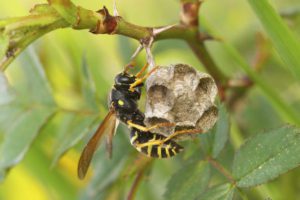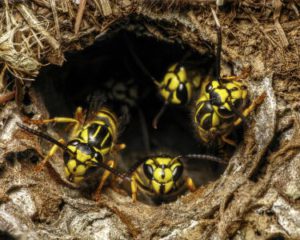SPRINGTIME WASPS ALREADY?
By Zachary Ciras on April 15, 2021.
It’s only April and I’m already seeing yellowjackets flying around! What gives? I thought yellowjacket nests died out in the winter. Are we in for a bad wasp year?

European Paper Wasp (Polistes sp.), building an umbrella nest.
First of all, what you saw may or may not be yellowjackets. Some other wasps look very much like yellowjackets: European paper wasps make those open “umbrella” nests under the eaves (and elsewhere). They’re black and yellow but are distinguished by orange antennae and orangey wings. European hornets look somewhat like very large yellowjackets but with rust markings; fortunately they are less common and less aggressive. There are even harmless flies that are yellowjacket mimics.
MOST WASPS AND BEES ARE NOT A CONCERN
You’re probably seeing what seems like excessive wasp activity now because they are all visiting those plants that bloom only in the springtime. While various wasps and bees are busy right now building nests and pollinating plants, don’t assume that they all are a threat. Yellowjackets are the most aggressive, most others are not aggressive. Even docile species can sting though if they or their nests are threatened. To find out which bees and wasps could be a concern for your family, see Can That Thing Sting Me?
In our region, wasps’ nests do generally die out in the winter cold – but future queens from last year’s nests survive the winter in protected places so that they can start new nests the following spring. Paper wasp queens are notorious for overwintering in home attics and wall voids. Wasps that you are seeing now are probably queens scouting for nest sites, or maybe the first brood workers are already out and about.
SMALL SPRING WASPS’ NESTS BECOME MEGA-HOTELS BY FALL
In April, yellowjacket nests would be pretty small with few workers having hatched out. But the nest then grows exponentially as the newly hatched workers take over nest construction, maintenance, and brood feeding and rearing, leaving the queen free to simply lay eggs. Most of us don’t really notice yellowjackets until mid to late summer when the nests have enough workers to attract attention and those workers become more aggressive. By fall, a mature yellowjacket nest can have 4,000 to 5,000 worker wasps.
GOT VOLES OR MICE? YELLOWJACKETS USE THEIR BURROWS
Here’s an interesting fact: yellowjacket queens often start their nests in abandoned rodent burrows. If you have a lot of voles (field mice) or deer mice nesting on your property, often in the vicinity of bird feeders or gardens, you may have more than your share of yellowjacket nests. A ground nest opening may be hidden in grass or vegetation, identifiable only by wasp traffic going in and out. Yellowjackets also build paper-covered nests in shrubs or trees, in tree holes or stumps, and even in building voids or attached to structures (see Dealing With a Wasps’ Nest Inside a Wall).

Southern Yellow Jackets (Vespula squamosa) at the entrance of Nest Hole in ground
And, if you had a lot of yellowjackets around your property last year, you may be in for more of the same. The future queens that leave a dying nest in the fall usually spend the winter nearby. These queens sometimes end up starting a new nest in the same area because for some reason the conditions there may be more favorable for nesting.
YOU CAN STOP MANY YELLOWJACKETS BEFORE NESTS GET LARGE
It’s always best to take care of a yellowjacket nest as early in the season as possible when the number of workers is still low. Small nests are easier and safer to eliminate. The best way to destroy the nest is to have a professional pest management company treat it to kill worker yellowjackets and developing young, as well as foraging yellowjackets that return to the nest. This usually involves injecting insecticide into the nest opening. Don’t attempt to do this on your own unless you really know what you’re doing and have proper protective gear. Nests inside homes require a specialized approach.
If you find a yellowjacket nest opening, or even if you don’t find the source of flying yellowjackets, give us a call. At Colonial Pest, we have technicians who are experts in tracking yellowjackets back to their nest. We can locate that nest and others in your yard and eliminate them before they get large enough to cause a real problem. Call Colonial!
See It’s Never Too Early to Control Yellowjackets
[NOTE: When it comes to ground nests, make sure you are dealing with yellowjackets, not beneficial ground-nesting bees or wasps that are basically harmless. And always protect threatened honey bee pollinators. Our Colonial technicians know the difference.]
And now, get ready for those large (but docile) black and yellow carpenter bees. They’re next up! See Carpenter Bees Are Nest Building…Again!